How To Repair Damaged Asphalt Driveway
4 Categories of Cobblestone Harm and iv of Our Almost Effective Repair Methods
Wondering if the damage on your pavement can be repaired, or if you're looking at replacement? Our experts share their nigh constructive repair methods to help y'all extend your cobblestone'due south life span and bring back its artful appeal.

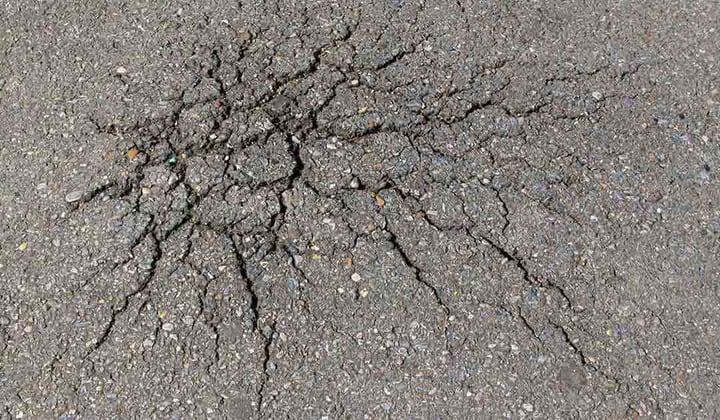
An asphalt pavement can only last for so long, before signs of ageing and deterioration outset showing on its surface. But similar our skin, constant exposure to the sunday, weather, natural elements, and stress tin cause damage, brittleness and flaking. Soon enough, you will brainstorm to notice cracks snaking their mode along the length of your driveway or parking lot, as well as patches of moss or algae, discolorations and fading, depressions, ruts and uneven sections. Below are four categories of asphalt harm based on severity. Our experts provide corresponding repair methods to counter them. Oxidation causes asphalt to fade and turn gray, especially if it is at to the lowest degree a few years former. Fresh asphalt more often than not has a rich black colour, due to the element chosen bitumen, a tar-like substance used as binder that holds together the aggregates in asphalt mixes. With constant exposure to the sun, bitumen slowly evaporates, while leaving backside the aggregates. This gives asphalt a faded appearance and indicates it is becoming brittle as it dries out. Unfortunately, the fading is often uneven, which ways that some sections might appear darker or lighter than others, making the surface of your asphalt expect cruddy. Moisture from rain, snowfall, drainage runoffs and spills is the major culprit that causes asphalt to deteriorate rapidly. When moisture seeps into unsealed asphalt, information technology gets trapped beneath the surface. During winter, this trapped wet freezes and expands, causing the foundation to weaken and the surface to split. Newer cobblestone with most of its bitumen content still intact can counter the effects of this continuous freeze-thaw bike by flexing to accommodate the expansion of frozen wet. However, as cobblestone ages and loses its flexibility, information technology becomes more brittle and vulnerable. Instead of flexing, the surface splits and cracks. This means that more wet can soak into the foundation and cause more damage. Cracks that are not filled in a timely fashion grow larger and form into potholes. Remove all forms of vegetation growing out of the cracks and potholes with a estrus lance or torch. Use a cleft cleaning motorcar, sweeper, blower, or a good old push broom with potent beard to make clean off loose debris and sand. Hose the entire surface of the pavement with clean water, or use a power washer. The idea is to fix fissure for filling. Allow the unabridged area to dry thoroughly. For cracks that are less than ½" use cold-pour crackfill. Apply hot-cascade rubberized crackfill on cracks that are 1" or less. For a broad network of cracks that looks like the skin of an alligator, use Gator Patch. For gaping potholes, we recommend using the cold patch cobblestone repair. If you are repairing during wintertime, following the ideal crack repair application temperature tin ensure the best results. For a more in-depth process on how to fill up cracks and potholes, bank check out the following resources pages: Guide to Cobblestone Crack Repair and Cobblestone Patching. When cracks and potholes are not filled correct away, the impairment tends to abound more extensive, especially in areas where in that location is loftier traffic, such equally in parking lots. Abiding stress from heavy vehicles and regular traffic tin can create depressions on the pavement surface or continuously chip off chunks of aggregate until the potholes grow too large for crackfill. When the holes on your pavement are too large and extensive for crack filler, we recommend cut out the damaged section using a gas-powered pavement saw. Clear the section of loose debris and cascade enough pothole repair patch until the material flush is with the rims of the cut-out. Tamp down with a handheld metallic tamper until completely compacted, adding and tamping every bit y'all go, until the surface of the patched hole is even with the rest of the pavement. Do the same for sunken and distressed areas. For larger areas, nosotros recommend using a vibrating plate compactor or an asphalt roller to get an even surface. Let the patch to cure for at least 24 hours and employ sealcoat for a uniform stop that protects the patch. If you're cleaning your driveway with a blower, gas-powered sweeper or broom, and y'all notice that larger pieces of the aggregate also get blown or swept away with the debris that you're trying to remove, your asphalt might be completely deteriorated and should be replaced. Depending on the extent of the actual damage, there are ii options that you can choose: Asphalt repair can be very plush, depending on the severity of the damage. Which is why we highly recommend that y'all fill cracks and potholes right away and sealcoat your driveways and parking lots every 2 to 3 years. This will help prevent extensive deterioration and having to spend too much for repair and restoration. Table of Contents
Category 1: Oxidation
The Solution: Sealcoating
Category 2: Cracks and Minor Potholes
The Solution: Crevice and Pothole Repair
Category 3: Large Holes, Ruts, and Uneven Depressions
The Solution: Cut, Patch, and Sealcoat
Category four: Crumbling Asphalt
The Solution: Repaving Damaged Asphalt

Category 1: Oxidation
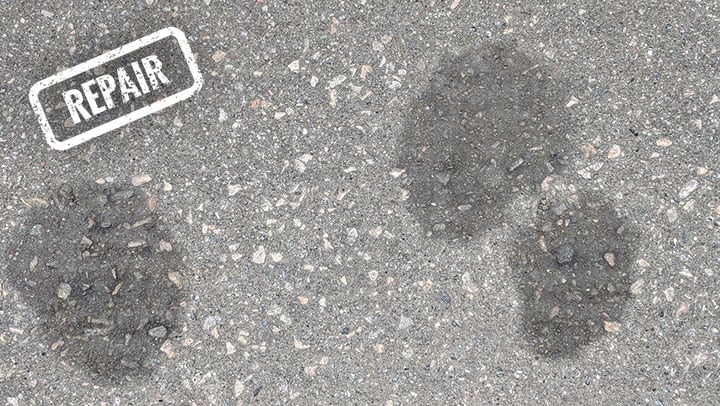
The Solution: Sealcoating
.jpg?width=443&name=AerialSealcoating1%20(1).jpg)
Requite your asphalt the protective brand-over information technology deserves by applying a fresh coat of sealer. Sealcoating not only brings back the beauty of your asphalt, it also creates a barrier that protects your pavement from straight exposure to the elements and a waterproof motion-picture show that prevents moisture from seeping into the foundation. Bank check out our comprehensive sealcoating guide for methods, tips, techniques, and best practices.
Category 2: Cracks and Small Potholes
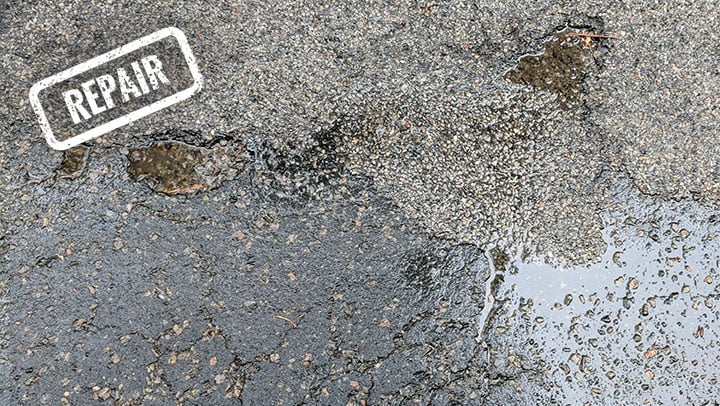
The Solution: Crack and Pothole Repair
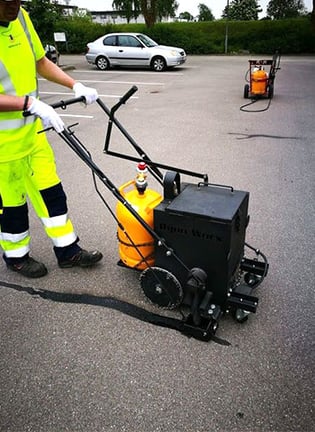

Category 3: Large Holes, Ruts, and Uneven Depressions

The Solution: Cut, Patch, and Sealcoat
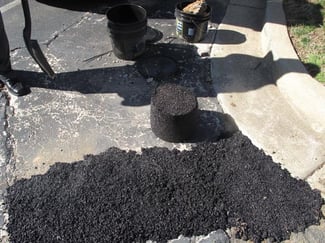
Category four: Crumbling Cobblestone
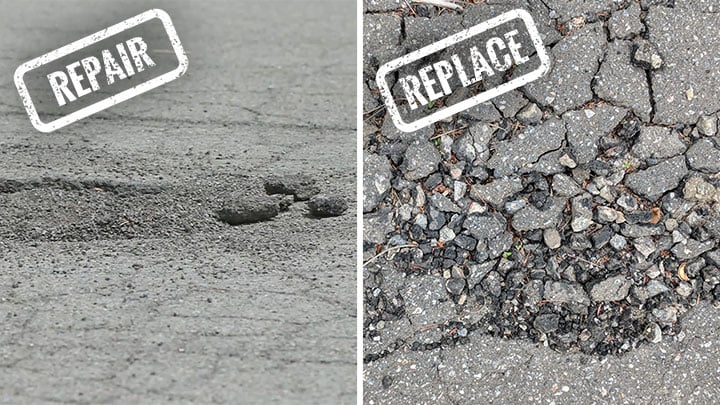
The Solution: Repaving Damaged Asphalt
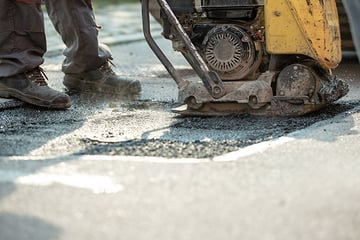
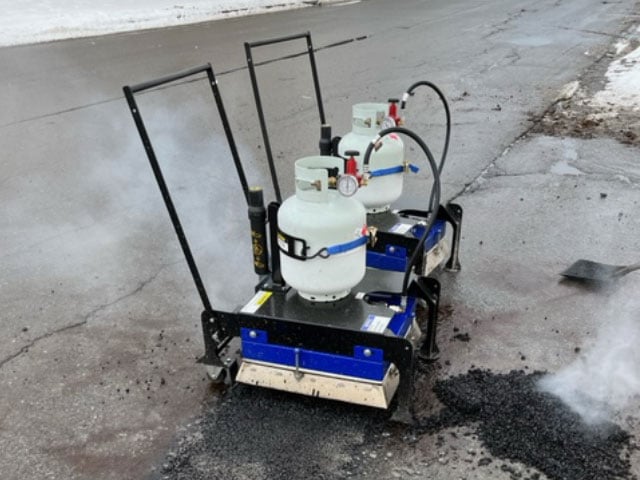


Sign-up beneath to become your own copy:
Topics: Asphalt Maintenance
How To Repair Damaged Asphalt Driveway,
Source: https://blog.asphaltkingdom.com/asphalt-damage-repair-methods
Posted by: ewingshoseathe1939.blogspot.com


0 Response to "How To Repair Damaged Asphalt Driveway"
Post a Comment